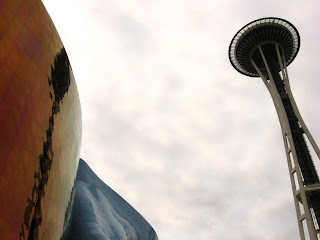As promised (though a mite delayed), here are some photography tips and tricks I gathered at the Professional Development Seminar at the SNAG conference in Seattle this year. There were several great speakers, so to properly give credit to everyone, I will divide the info into sections by speaker.
Doug Yaple - Photographer
- when doing product photography for art, the artwork itself drives the decision on how to represent the work. (i.e. if you have natural organic inspired work, you may want to photograph it in that sort of setting, displayed on dirt or stones, or hang a necklace over a branch, etc. - this applies to advertising,
not photographing work for exhibitions, etc.)
- it is critical to position the work so that it tells the story. (highlight the most important aspect of the work)
- bring out important textures
- background is very important to showcase the piece
- it must highlight the piece but not distract from it
- body forms can work to display jewelry and wearable art
- creating shadows can emphasize certain elements
- take several shots and explore from different angles (you might be surprised what looks good in a photo vs. what looks normal in person)
- don't overlook getting in tight to access something critical. (details are great!)
Christopher Conrad - Product Photographer
- work with good light - natural is the best
- a room with large picture windows is perfect
- do not mix different kinds of light
- no flourescent or incandescent lights
- build a softbox for direct light (frame with pvc, cover with thin vellum or
ripstop nylon
- always use a tripod
- this allows for slower shutter speeds and/or smaller apertures (smaller apertures = greater depth of field)
- don't use a high ISO - lower ISO's reduce "noise"
- be optically square to flat geometric objects
- don't fill the frame, crop images later
- for knockouts (isolating images),
adding a drop shadow in photoshop adds a ground to the object and eliminates the "floating" look.
Roger Schreiber - Comtemporary Craft Photographer
- ask yourself, "who is your audience?" this will indicate how you should photograph your work
- everything that falls within the frame has an effect on the viewer
- for advertising, use energy in the background
- for juries, isolate the image
- when you're setting up for photographing work, make sure to allow yourself enough time
- think about models if you're using them - clothing, hair, make-up
- make a list of everything you need, props, etc
- think about the photograph even while you're making the piece (if you start the thought process early, you will think about what are the best angles and details, etc. that you want to include in your shots)
Suzanne Ramljak - Editor of Metalsmith Magazine
- make sure you have a shot that establishes your work for what it is
- acknowledge our media-saturated culture - you're in competition with all the other images out there
- remember that reprouctions on the web are never perfect and will look different than the original
- you have to just accept that and put your best image out there
Marthe Le Van - Editor for Lark Books
- the body is the best surface for photographing jewelry
- indicates scale and drape
- gives life to the work - makes it dynamic and dramatic
- traditional American Craft photography has used a gradated background with careful lighting, but now a white background is becoming more and more popular
- Scandinavian images are using and dynamic models, which creates a very striking image
- this has the effect of presenting the piece as more wearable and more accessible
- remember that on gallery websites and search engines, you often just have one tiny image and your name to grab people's attention and get them to browse through you work. use something dynamic!
- have a style for all of your photos to follow to make them work together
- black or white backgrounds tend to grab readers because they make the piece stand out.
So thank you to all of the above artists for all of your great information and tips! That definitely gives me a lot to think about when photographing my work. And it points out some mistakes I have been making with lighting, etc, too. So I hope some readers will find this helpful as well. Let me know of you have some other tips and tricks! I'd love to hear from you! Thanks for reading!










